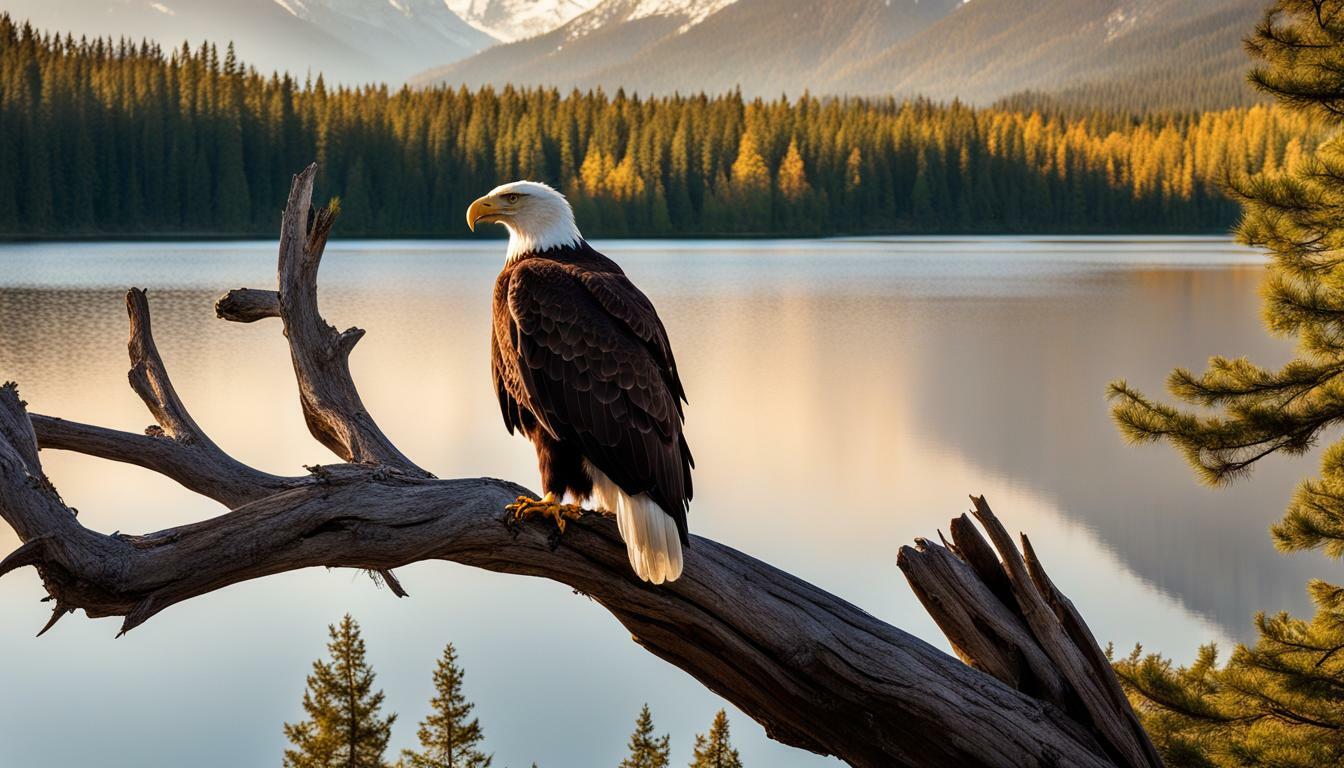When you think of bald eagles, hydration habits may not be the first thing that comes to mind. However, water is a crucial component of their well-being and survival. In this article, we will explore the many facets of bald eagles’ hydration habits and their importance in their ecosystems.
Key Takeaways:
- Bald eagles require water to maintain their bodily functions and overall health.
- They obtain water from various sources, including freshwater and their prey.
- Water availability and environmental factors can impact their drinking habits.
- Water preservation efforts can contribute to the conservation of bald eagles.
The Water Intake of Bald Eagles
Have you ever wondered how bald eagles stay hydrated? Unlike humans, these majestic birds cannot simply walk over to the nearest water fountain for a drink. Instead, they have adapted unique strategies to ensure that they receive an adequate water intake.
On average, bald eagles consume about 10% of their body weight in water per day. This translates to roughly one pound of water. However, their water intake can vary depending on various environmental factors.
During periods of extreme heat or dryness, bald eagles may drink more water to prevent dehydration. They also tend to consume more water when their diet consists of saltier prey, such as fish from saltwater bodies of water.
The Water Intake of Bald Eagles
So, where do bald eagles get their water from? They primarily obtain water from the prey they consume, such as fish, waterfowl, and small mammals. However, they can also drink from freshwater sources, such as streams, lakes, and rivers. Interestingly, bald eagles have been observed drinking from saltwater sources, indicating their ability to tolerate increased salt levels.
While bald eagles have adapted to obtain water from their food sources, they do not rely solely on this method. Bald eagles also store water by absorbing it through their skin during rainfall or while standing in shallow water.
Overall, bald eagles have developed various methods to stay hydrated and thrive in their natural habitats. Their unique adaptations and behaviors highlight the crucial role of water in their lives and emphasize the importance of protecting their access to clean water sources.
The Sources of Hydration for Bald Eagles
If you’ve ever wondered how bald eagles stay hydrated in their natural habitats, you’ll be interested to know that these magnificent birds have a few techniques up their wings. Let’s explore the sources of hydration for bald eagles.
Do Bald Eagles Obtain Water from Their Prey?
Bald eagles often hunt for prey near water, such as fish or ducks, but they do not get hydrated from their prey. The moisture content of their prey is not sufficient to meet their hydration needs, so bald eagles need to obtain water from other sources.
Do Bald Eagles Drink Freshwater or Saltwater?
Unlike humans and many animals, bald eagles can drink saltwater! Their bodies are equipped to filter out salt, allowing them to consume both freshwater and saltwater sources for hydration.
| Bald Eagles’ Sources of Hydration | Examples |
|---|---|
| Freshwater | Rivers, lakes, streams, and ponds |
| Saltwater | Coastal estuaries, bays, and oceans |
It’s important to note that bald eagles do prefer freshwater sources when they are available, but they have the ability to adapt to different environments.
Now that you know where bald eagles get their hydration from, let’s explore why water is so important for their survival in the next section.
The Importance of Water for Bald Eagles
Water is a crucial element in the diet and survival of bald eagles. These majestic birds depend on water for various bodily functions, including digestion, respiration, and thermoregulation. Without adequate hydration, bald eagles would struggle to maintain their energy levels and overall health.
One of the primary reasons water is important to bald eagles is because it plays a vital role in regulating their body temperature. As birds of prey, they need to maintain a consistent body temperature to support their extensive activities, such as hunting, flying, and nesting. Water helps them to cool down when it’s hot outside and retain heat when it’s cold.
Furthermore, bald eagles need water to digest their prey properly. They typically consume fish, which contain high levels of protein and are challenging to digest. Water facilitates the breakdown of the food in their stomachs, making it easier for them to extract the nutrients they need.
Bald eagles also need to stay hydrated to support their kidney function. These organs help remove waste from their bodies, and they require sufficient water to function correctly. Without enough water, bald eagles would be at risk of kidney damage, which could prove fatal.
In summary, water is a vital component of bald eagles’ overall well-being. It supports their body temperature regulation, digestion, and kidney function, among other essential bodily processes. Therefore, ensuring that they have access to clean and abundant water sources is crucial to their survival.
The Water Intake of Bald Eagles
When it comes to their water intake, bald eagles typically consume between 200-400 milliliters of water per day. However, this amount may vary depending on factors such as temperature, humidity, and prey intake. Eagles can obtain water from a variety of sources, including their food and freshwater bodies.
While bald eagles primarily consume fish, they may also prey on other animals such as rabbits, squirrels, and ducks, which have varying water content in their tissues. Drinking freshwater is the most common method for eagles to hydrate themselves, although they have been known to drink from saltwater sources as well. Eagles have a special salt gland that allows them to filter out excess salt from their diet, making saltwater less of a concern.
Do Bald Eagles Have a Special Way of Obtaining Water?
While bald eagles do not have any unique adaptations specifically for obtaining water, they have been observed using certain behaviors to help them access it. For example, eagles will often bathe in shallow water sources, which may also serve as a means of hydration. Additionally, eagles have been seen swooping down to the surface of the water and scooping up a beak-full of water before flying off to consume it elsewhere.
Overall, bald eagles’ water intake and sources of hydration are critical to their survival. Through various adaptations and behaviors, eagles are able to optimize their water consumption and thrive in their environments.
The Relationship Between Bald Eagles and Water Bodies
Bald eagles have a strong connection with water bodies, and it’s no surprise why. They require water for their daily activities, including hunting and preening. Their natural habitats consist of coastlines, lakeshores, and rivers, making water a vital element of their ecosystem.
When it comes to nesting sites, bald eagles often choose locations near water sources, such as on a cliff overlooking a river or on a tree by the shore of a lake. They also tend to roost near water, which provides an added layer of protection and resources for survival.
Observing bald eagles in their natural habitat can be an incredible experience, as they often exhibit fascinating behaviors around water. They are known to swoop down to the surface of a lake or river to catch fish, using their powerful talons to grasp their prey. You may also witness them soaring high above the water, scanning the surface for potential meals.
Bald eagles also take advantage of the water’s reflective surface when hunting. They may fly low over the water to take advantage of the reflections that can help them spot fish swimming below the surface.
Overall, water is a crucial element of bald eagles’ lives, and their habitat and behavior reflect this reliance. By understanding their connection to water, we can better appreciate and protect these magnificent creatures.
The Water Conservation Techniques of Bald Eagles
Bald eagles have developed several water conservation techniques to help them optimize their water intake and minimize water loss.
One of these techniques is called “panting.” When bald eagles are hot and thirsty, they may open their beaks and flutter their throats to accelerate evaporation and cool themselves down. This helps them conserve water and regulate their body temperature.
Bald eagles also have an acute sense of thirst. They can detect the slightest changes in their body’s hydration levels and adjust their behaviors accordingly. For example, if they feel dehydrated, they may reduce their physical activity and search for water sources more actively.
Finally, bald eagles are careful with their water sources. They avoid contaminating them with their feces or other waste materials, which can lead to bacterial infections or other diseases. This helps them maintain their water quality and ensure a reliable source of hydration.
Factors Affecting Bald Eagles’ Water Consumption
While bald eagles require water like any other living creature, their drinking habits can be impacted by a variety of factors. These factors can include:
- The availability of water sources in their habitat
- The season and weather conditions
- Their food source and its water content
- The eagle’s physical condition and age
In regions where water sources are scarce, bald eagles may need to travel long distances to find water. This can affect their hunting and nesting behavior as well. When water sources freeze over, eagles may need to rely on their food as a source of hydration.
Bald eagles in good physical condition are better equipped to handle dehydration and may drink less water than those who are struggling. Young eagles may also have different drinking habits than mature adults.
Overall, understanding the various factors that impact bald eagles’ water consumption is crucial to their conservation and well-being.
The Role of Water in Bald Eagles’ Survival
Access to water is crucial for bald eagles’ survival. Water plays a vital role in their bodily functions and overall health. Without sufficient hydration, bald eagles may experience various health problems such as dehydration, heat stress, and kidney damage. To maintain their health and survive in their ecosystems, bald eagles need to have access to clean and abundant water sources.
Bald eagles obtain water from various sources such as freshwater bodies like lakes, rivers, and streams. They may also drink from rainwater or snowmelt. However, some bald eagles living near the coasts may consume saltwater if freshwater is scarce.
Bald eagles also rely on water bodies for food sources since they primarily feed on fish, which live in water. Nesting near water sources provides convenience for the bald eagles to hunt for prey.
Protecting water sources is crucial for the conservation of bald eagles. Water preservation efforts contribute directly to maintaining the bald eagle’s well-being and survival. It is essential to ensure that the water bodies and food sources of bald eagles are free from pollution and other environmental hazards. By preserving their water sources, we can help support the survival and overall health of these magnificent birds.
Adapting to Different Water Conditions
Did you know that bald eagles are capable of consuming both freshwater and saltwater? This adaptability is a key survival strategy for these birds of prey.
Bald eagles primarily consume freshwater, but they can also tolerate the high salt content of marine environments to some extent. They have special adaptations that allow them to process excess salt and maintain proper electrolyte balance in their bodies.
In areas where freshwater sources may be limited, such as coastal regions, bald eagles have been observed drinking seawater. However, this is not a preferred source of hydration for them and can lead to dehydration if consumed in large quantities.
Bald eagles have also been observed eating ice and snow to obtain water during the winter months when freshwater sources may be frozen over. This behavior highlights their ability to adapt to changing environmental conditions.
Overall, bald eagles’ ability to consume both freshwater and saltwater allows them to thrive in a variety of habitats. This adaptability is a testament to their resilience and survival skills.
Promoting Bald Eagle Conservation through Water Preservation
If you want to contribute to the conservation of bald eagles, preserving water sources is one of the most important things you can do. Bald eagles are dependent on bodies of water for their survival, as they need water not just for drinking but also for hunting and nesting.
By keeping water sources clean and ensuring their availability, you can help protect bald eagles and their habitats. This includes refraining from polluting bodies of water and conserving water whenever possible. Simple steps like fixing leaky faucets and reducing water usage can make a big difference in ensuring that bald eagles have access to the water they need to thrive.
You can also support organizations dedicated to protecting bald eagles and their habitats. These organizations work to preserve natural habitats and promote the conservation of bald eagles and other wildlife. By supporting their efforts, you can help ensure that these majestic birds continue to survive for generations to come.
Conclusion
Congratulations, you’ve learned a lot about bald eagles and their hydration habits! You now know that bald eagles do drink water and that it is crucial to their overall health and well-being. From understanding their water intake and sources of hydration to exploring their unique adaptations and behaviors, you have gained valuable insight into the world of these magnificent birds.
Remember, water conservation efforts are essential to preserving bald eagle populations and their habitats. By protecting the water sources vital to their survival, we can help ensure that these majestic creatures continue to thrive for generations to come.
So the next time you see a bald eagle soaring high in the sky, remember their dependency on water. Whether they are nesting near a river or hunting over a lake, water is an integral part of their lives. Thank you for learning and caring about these amazing birds!
Are Teeth Present in a Bald Eagle’s Beak?
Bald eagles’ dental structure and existence is intriguing. While they lack teeth, their beaks are designed for tearing and gripping food. The beak’s hooked shape allows them to rip flesh, while the sharp edges help shear meat from bones. Their diet primarily consists of fish, so their beak’s adaptation suits their hunting and feeding needs perfectly.
FAQ
Q: Do bald eagles drink water?
A: Yes, bald eagles do drink water. Water is essential for their hydration and overall well-being.
Q: How do bald eagles stay hydrated?
A: Bald eagles stay hydrated by drinking water from various sources, including lakes, rivers, and other bodies of water.
Q: Do bald eagles get water from their prey?
A: Bald eagles primarily obtain water from drinking, rather than relying on their prey as a source of hydration.
Q: Do bald eagles drink freshwater or saltwater?
A: Bald eagles typically drink freshwater, as they are not well adapted to consuming saltwater.
Q: What is the importance of water for bald eagles?
A: Water plays a vital role in the lives of bald eagles, contributing to their physiological functions and overall health.
Q: Do bald eagles have a special way of obtaining water?
A: Bald eagles do not have any unique adaptations for obtaining water. They rely on traditional drinking methods.
Q: What is the relationship between bald eagles and water bodies?
A: Bald eagles are closely associated with water bodies, as they often nest near them and rely on them for food and hydration.
Q: How do bald eagles conserve water?
A: Bald eagles optimize their water intake and minimize water loss through efficient physiological mechanisms.
Q: What factors affect bald eagles’ water consumption?
A: Environmental factors, availability of water sources, and other variables may impact bald eagles’ drinking habits.
Q: What role does water play in bald eagles’ survival?
A: Water is crucial for bald eagles’ survival, directly impacting their ability to thrive in their ecosystems.
Q: Can bald eagles drink both freshwater and saltwater?
A: Bald eagles are primarily adapted to drinking freshwater and may struggle with consuming saltwater.
Q: How can water preservation contribute to bald eagle conservation?
A: By preserving water sources, we can ensure the availability of vital habitats for bald eagles and contribute to their conservation.










